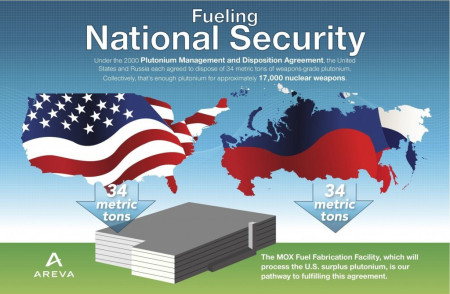On May 13, Japan’s Nuclear Regulation Authority announced that the nuclear fuel reprocessing plant in Rokkasho, Aomori Prefecture, had met new safety standards created after the March 11, 2011, earthquake and tsunami….The Rokkasho plant is a 3.8 million square meter facility designed to reprocess spent nuclear fuel from the nation’s nuclear reactors. Construction began in 1993. Once in operation, the plant’s maximum daily reprocessing capacity will be a cumulative total of 800 tons per year. During reprocessing, uranium and plutonium are extracted, and the Rokkasho plant is expected to generate up to eight tons of plutonium annually.
Both are then turned into a mixed uranium-plutonium oxide (MOX) fuel at a separate MOX fabrication plant, also located in Rokkasho, for use in commercial reactors. Construction on the MOX facility began in 2010 and it’s expected to be completed in 2022. Japan had originally envisioned MOX fuel powering between 16 and 18 of the nation’s 54 commercial reactors that were operating before 2011, in place of conventional uranium. But only four reactors are using it out of the current total of nine officially in operation. MOX fuel is more expensive than conventional uranium fuel, raising questions about how much reprocessed fuel the facilities would need, or want.
The Rokkasho reprocessing plant can store up to 3,000 tons of spent nuclear fuel from the nation’s power plants on-site. It’s nearly full however, with over 2,900 tons of high-level waste already waiting to be reprocessed.
Why has it taken until now for the Rokkasho plant to secure approval from the nuclear watchdog? Decades of technical problems and the new safety standards for nuclear power that went into effect after the 2011 triple meltdown at the power plant in Fukushima Prefecture have delayed Rokkasho’s completion date 24 times so far. It took six years for the plant to win approval under the post-3/11 safety standards…By the time of the NRA announcement on May 13, 2020, the price tag for work at the Rokkasho plant had reached nearly ¥14 trillion.
Japan is the only non-nuclear weapons state pursuing reprocessing. But as far back as the 1970s, as Japan was debating a nuclear reprocessing program, the United States became concerned about a plant producing plutonium that could be used for a nuclear weapons program. The issue was raised at a Feb. 1, 1977, meeting between U.S. Vice President Walter Mondale and Prime Minister Takeo Fukuda. “Reprocessing facilities which could produce weapons grade material are simply bomb factories,” noted a declassified U.S. State Department cable on the meeting. “We want to cooperate (with Japan) to keep the problem under control.”
The U.S. oppose the Rokkasho plant’s construction in 1993, following an agreement in 1988 between the two countries on nuclear cooperation. ..The U.S.-Japan nuclear agreement meant the U.S. would give advance consent for Japan to send spent nuclear fuel to the United Kingdom and France — states with nuclear weapons — for reprocessing until Rokkasho was running at full-scale.
Currently, Japan has nearly 45 tons of plutonium stockpiled, including 9 tons held by domestic utilities. Another 21.2 tons is in the United Kingdom and France is holding 15.5 tons under overseas reprocessing contracts.
Thus, Japan finds itself caught between promises to the international community to reduce its plutonium stockpile through reprocessing at Rokkasho, and questions about whether MOX is still an economically, and politically, viable resource — given the expenses involved and the availability of other fossil fuel and renewable energy resources.
Excerpts from Aomori’s Rokkasho nuclear plant gets green light but hurdles remain, Japan Times, May 31, 2020


 South Carolina is suing the U.S. government to recover $100 million in fines it says the Department of Energy owes the state for failing to remove one metric ton of plutonium stored there. The lawsuit was filed on August 7, 2017.
South Carolina is suing the U.S. government to recover $100 million in fines it says the Department of Energy owes the state for failing to remove one metric ton of plutonium stored there. The lawsuit was filed on August 7, 2017.
